Vukovar Bids Wartime Hospital Director Vesna Bosanac Farewell
ZAGREB, 24 March 2022 - Numerous Vukovar residents bid farewell to the wartime hospital director Dr Vesna Bosanac at the Homeland War Memorial Cemetery in Vukovar on Thursday.
Addressing those present at the burial ceremony, Dr Bosanac's long time deputy Siniša Maslovara bid her farewell.
"Most of us will remember her for caring for us all. She supported us and was there whenever we needed her, particularly when a serious misfortune or illness afflicted us. She loved her employees and fought for them to the limits of durability, even when everyone would leave them and when, sometimes, they would lose faith in themselves," Maslovara said.
He said that Bosanac seemed indestructible because she survived numerous misfortunes.
In the most difficult times for the hospital during the Homeland War, Dr Bosanac showed unimaginable courage, audacity and organisational skills, he underscored.
In addition to numerous Vukovar residents, also present at the funeral were the prime minister's envoy, Defence Minister Tomo Medved, Defence Minister Mario Banožić, Health Minister Vili Beroš, Vukovar-Srijem County Prefect Damir Dekanić and Vukovar Mayor Ivan Penava, who proclaimed today a day of mourning.
Vukovar Hospital staff paid their final respects to Dr Bosanac prior to her being taken to the cemetery. A commemorative ceremony will be held later this afternoon.
Vesna Bosanac died on Monday after a long and serious illness. She was 73.
Politics: For more, check out our politics section.
HUB: Number Of Requests For Basic Payments Account Not Significant
ZAGREB, 24 March 2022 - Banks have started with preparations or have already introduced technical solutions to secure access to the basic payments account for refugees from Ukraine, the Croatian Banking Association (HUB) has said, noting that according to available information, the number of such requests is not big.
The Croatian National Bank (HNB) on Monday informed banks based in Croatia that it expected them to provide free access to a basic payments account, including ten free-of-charge national and international transactions in kuna and euros, for refugees from Ukraine legally staying in Croatia.
The HNB said that one of the most severe consequences of the Russian invasion of Ukraine was the resettlement of a large number of civilians. In those conditions, access to basic financial services is a necessary precondition for the normalisation of life for refugees and their integration, the central bank said.
In response to a query from Hina, HUB said that it did not have detailed statistics at present but that according to available information, the number of requests for a basic payments account was not significant.
"As before, banks have started preparations or have already implemented technical solutions to enable access to the basic payments account for Ukrainian refugees," HUB said, noting that the basic payments account enables refugees to use a kuna current account and a related debit card. They can also make payments and withdraw money at bank offices or on ATMs and use internet or mobile banking.
In addition to the minimum ten free national or international transactions in kuna and euros, some banks will offer the refugees additional facilities.
So far, 9,500 Ukrainian refugees have arrived in Croatia.
Business: For more, check out our business section.
MPs Welcome Greater Use Of Green Energy And Hydrogen Strategy
ZAGREB, 24 March - Members of the Croatian Parliament on Thursday welcomed the proposal for a national hydrogen strategy until 2050, stressing the importance of economic development based on hydrogen, own energy production and increased electricity production from renewable sources.
Some opposition lawmakers warned of the commercial unprofitability of green hydrogen.
In recent years, Croatia has been making a great effort in decarbonising its energy sector and economy, its goal being to ensure that by 2030 at least 36.6 per cent of electricity consumption comes from renewable sources, said Ivo Milatić, state secretary at the Ministry of Economy.
A hydrogen-based economy is an important part of plans by EU member states towards a green energy transition, and the proposed strategy follows up on the EU hydrogen initiative, which Croatia signed in 2018, he said.
The proposal puts emphasis on renewable hydrogen, obtained by low-carbon emitting technologies. Some sectors of the Croatian economy have already expressed an interest in developing hydrogen technologies, which is why a government strategic document is needed to give direction to the development of hydrogen technologies, Milatić said.
Ljubica Maksimčuk of the ruling Croatian Democratic Union (HDZ) was interested in whether Croatia was ready for the first phase of the strategy, from 2020 to 2024, which aims to ensure the production of one million tonnes of renewable hydrogen.
"Croatia is ready for this. Under the National Recovery Plan, we have undertaken to install 10 refuelling stations over the next three years and finance a certain number of electrolysers," Milatić said, adding that there was interest from hydrogen associations and private and public companies.
In response to a question put by Andreja Marić of the Social Democratic Party (SDP), Milatić said that 60 public transport buses in Zagreb would switch to hydrogen use and that a hydrogen refuelling station would be installed for that purpose.
Vesna Vučemilović (Sovereignists) wanted to know why the proposed strategy gave priority to transport over industry and to green hydrogen, which she said would have to be subsidised because it was commercially unprofitable.
Milatić said that Croatia was rich in renewable energy sources and that it would not be wise to go any other way than green hydrogen. He, however, noted that they were aware that ample government subsidies would be necessary as long as this technology did not become cheaper.
Responding to a question from independent MP Hrvoje Zekanović about the price of a kilogram of hydrogen, Milatić said that its price currently ranged between 12 and 15 euro and that a car with six kilos of hydrogen in the tank can drive between 500 and 600 kilometres.
Marin Miletić (Bridge) said that the EU planned to invest about €500 billion in renewable energy sources by 2050 and Croatia more than HRK 70 billion (€9.3bn), which is equivalent to the cost of 17 Pelješac bridges. He asked Milatić where Croatia would get that money from.
Milatić said that conventional renewable energy sources, such as wind and sun, would require minimum or no state subsidies in the near future. "Our focus will be on small solar cells on houses and on new technologies, and among new technologies, hydrogen will dominate financially and in any other respect."
Politics: For more, check out our politics section.
Croatia Registers 2,061 New COVID Cases, 9 Related Deaths
ZAGREB, 24 March - Croatia has registered 2,061 new coronavirus cases in the past 24 hours and 9 patients have died as a consequence, the national COVID-19 crisis management team said on Thursday.
There are currently 11,448 active cases, including 631 hospitalised patients, 41 of whom are on ventilators. There are also 6,843 people who are self-isolating.
Croatia has registered a total of 1,089,696 cases of COVID-19 since its first registered case on 25 February 2020, and 15,485 people have died as a consequence while 1,062,763 have recovered from the contagion.
To date, a total of 2,236,999 people have been fully vaccinated, which is 65.68% of the adult population.
Coronavirus: For all you need to know about coronavirus specific to Croatia, make sure to bookmark our dedicated sectionand select your preferred language if it isn't English.
9,500 Ukrainians Find Refuge In Croatia So Far
ZAGREB, 24 March - About 9,500 Ukrainians displaced by the war in their country have found refuge in Croatia, Tomislav Marević of the Civil Protection Directorate said on Thursday.
"These are still mainly women and children, and many of them are accommodated privately," Marević said in an interview with Croatian Radio.
He said he was proud that Croatia had responded in solidarity already in the first weeks of the war and that citizens were taking in displaced persons voluntarily.
He commended the government's decision to finance accommodation for refugees, adding that the Civil Protection Directorate would sign a contract with each user and owner of a property.
Anny Brusić, director of the association of small and medium-sized enterprises at the Croatian Employers' Association (HUP), said that the business community was very interested in hiring Ukrainian refugees.
"We need a little more time to get the system going because certain procedures need to be simplified before hiring actually begins. A state authority should say that at this point Ukrainian workers are not required to show a certificate of education or a diploma. Our legislation is rather rigid," Brusić said.
Politics: For more, check out our politics section.
Cultural And Creative Industries See Sharp Declines In Revenues During Pandemic
ZAGREB, 24 March 2022 - Croatia's cultural and creative industries have recorded sharp declines in revenues since pre-pandemic 2019, of 8.5 per cent on average, with some segments, such as music, film and art, having seen their revenues plunge by as much as 40, 35 and 25 per cent respectively, a conference was told in the eastern city of Osijek on Wednesday.
A study on the impact of the COVID-19 pandemic on the Croatian cultural and creative industries, which the Ministry of Culture commissioned from the Zagreb Institute of Economics, also shows that some segments, such as video games, have seen increases in revenues since 2019, said Nenad Marčec, director-general of the Croatian Association of Composers.
Last year was still about 12% below the 2019 levels, but given that there were not many concerts and the tourism industry and cinemas operated at a reduced capacity, this is acceptable because a lot of revenues were generated from YouTube, Netflix and some other platforms that now have a large number of subscribers in Croatia. In 2015, there were about 2,000 subscribers to these services, and now there are 200,000, which is "a tectonic shift" that occurred during the pandemic and helped authors weather this crisis, he said.
Asked by the press what he expected from the new Copyright Act, Marčec said that it entered into force in December 2020 and would ensure the implementation of new directives on copyright on the digital market, which regulate the responsibilities of Facebook, YouTube, TikTok and Instagram for the use of copyright and make it possible for authors to get their fees. He said that these services had become multimillion companies that paid the authors hardly anything and the new law should benefit the authors.
Politics: For more, check out our politics section.
Dukat Teaches Croatian Schoolchildren About Forest Protection
March 24, 2022 - The new edition of the educational eco-project "Dukatići preserve forests and nature" is an upgrade of the long-standing project "I LOVE MILK!'', where Dukat teaches Croatian schoolchildren about forest protection and announces the planting of 10,000 tree seedlings.
On the occasion of World Forest Day and World Water Day, Dukat presented a new edition of the educational eco-project "Dukatići protect forests and nature", this way Dukat teaches Croatian schoolchildren in an interactive way about the importance of caring for forests and the environment, reports Telegram.hr.
The project is enriched with new content related to the preservation of forests and the rich forest world and consists of short educational stories on the website Dukatići preserve nature. Each story ends with a quiz, and students who successfully solve them receive a diploma and a memory game as a gift that arrives at their home address. With this, the students join the curious company of Dukatić - the conservationist, which has almost 4,000 members after last year's first edition. Under the auspices of the Ministries of Science and Education, this year's project is supported by the Ministry of Economy and Sustainable Development, and the project partners are Croatian Forests and Bioteka, an association for the promotion of biology and related sciences.
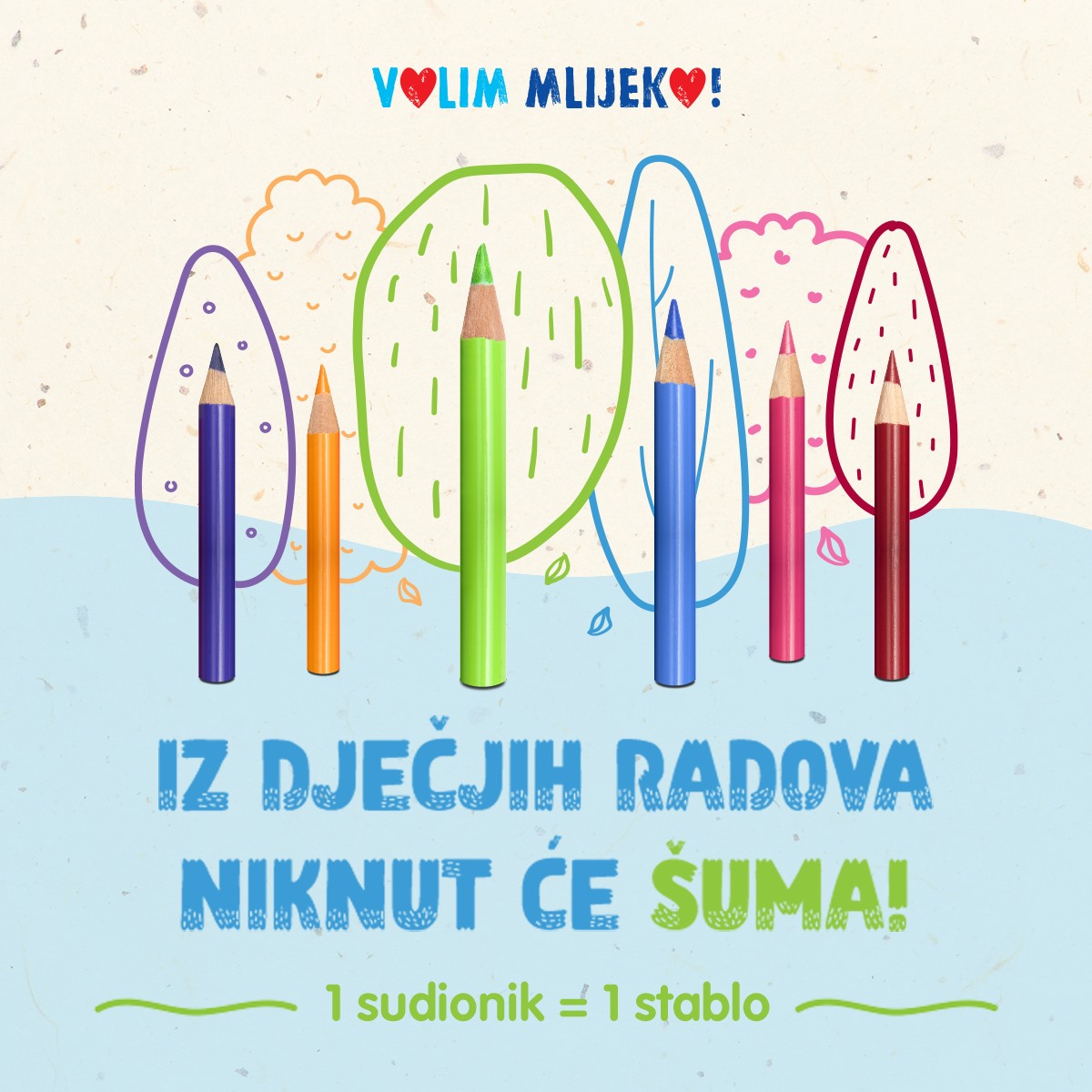
''I love milk! A forest will sprout from children's works! 1 participant = 1 tree'' (Dukat Hrvatska/Facebook)
“After motivating students in the previous edition of the project to separate waste and change habits that have a positive impact on environmental protection, we are now turning their attention to the green lungs of the Earth. I believe that it is our children who will very soon initiate great changes in this area and I am glad that we can contribute to this in this way while educating and entertaining them at the same time", said prof. Kristina Duvnjak, vice president of the Bioteka association and head of the education program.
This year's project "Dukatići preserve forests and nature" is a continuation of the project "I LOVE MILK!", another educational and socially responsible initiative of Dukat in which more than 7,300 students participated this fall, and in the past ten years 40,000 lower grade students. The contest "I LOVE MILK!" marks the tenth anniversary, and members of the expert jury and the audience on the Dukat Facebook profile have selected the ten best works of art of the forest, and the authors were awarded by Dukat.
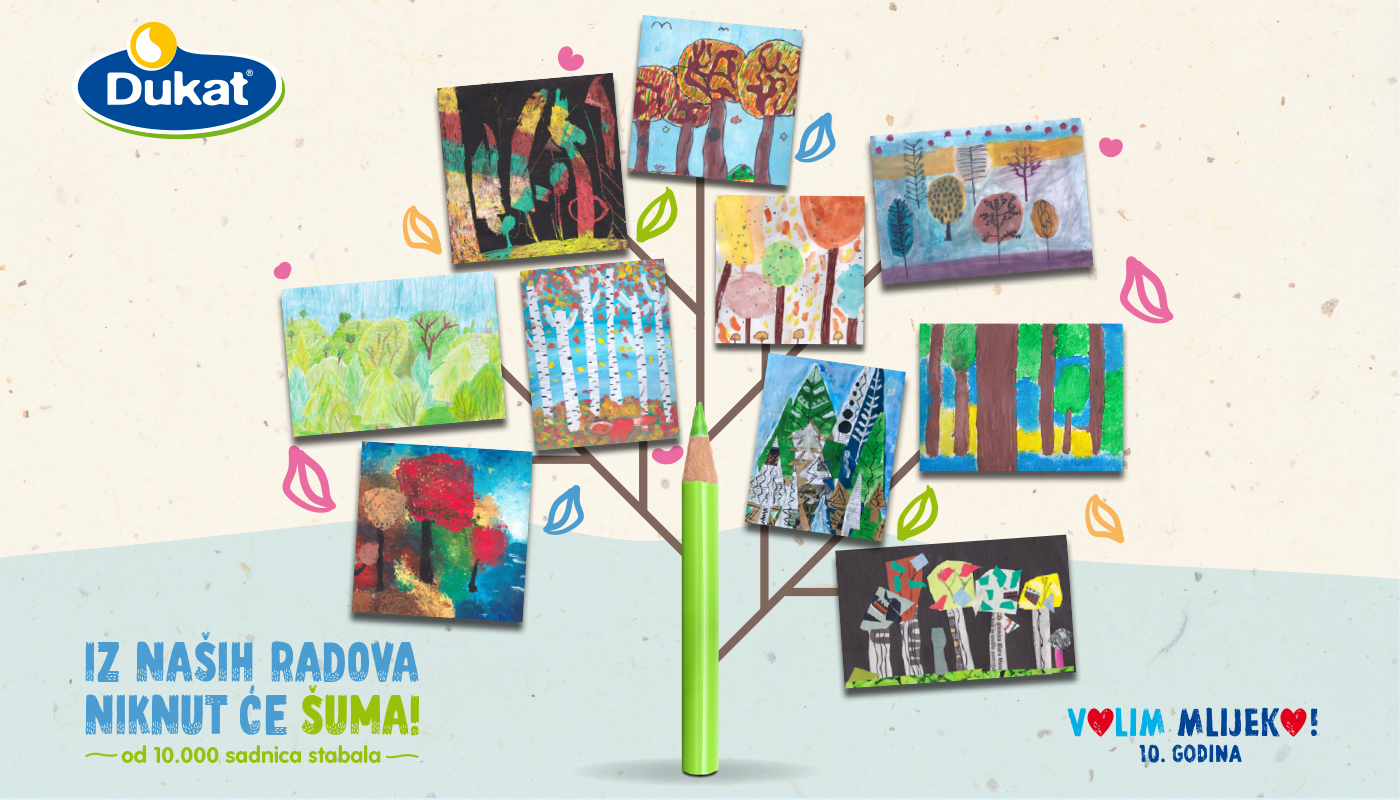
The winner projects. (Dukat Hrvatska/Facebook)
"The forest, as the topic of the tenth art competition and the second edition of Dukatić, additionally connected these two projects: students first drew forests, now Dukat teaches Croatian schoolchildren how to protect and love them, and by planting 10,000 seedlings we show their concrete contribution to forest fund renewal. We are happy that every year about 400 primary schools participate in our initiatives, which are slowly becoming an integral part of additional classes when it comes to environmental protection or art creation", said Kristina Klarić Rubčić, Head of Corporate Communications at Dukat.
Another link with the ten-year anniversary and the theme of both projects is the planting of 10,000 tree seedlings that Dukat, in cooperation with Croatian Forests, will plant this spring in Gorski Kotar and the surroundings of Velika Gorica.
For more, check out our lifestyle section.
Lika Tourism: Sights You Shouldn’t Miss on Your Way from Zagreb to Split
24 March 2022 - As the Mediterranean sun returns to its full vernal glory, summer is fast approaching, and innkeepers across Croatia are preparing for a busy tourist season. If you happen to be one of the lucky holidaymakers who've got Croatia on this year’s itinerary, pay attention because I want to share with you one of Croatia’s best-kept secrets which you should be sure not to skip on your way from Zagreb to Split.
Located directly in the path of anyone travelling from central Europe to the Dalmatian coast, Lika is a Croatian treasure that is often forgotten. A rugged land nestled in the Dinaric Alps, Lika’s geographic seclusion and small population manifests as both a blessing and a curse, leaving the region relatively untouched by the annual tourism booms that flood neighbouring areas. While this trend has preserved the local authenticity of the towns and villages that dot the valleys, coasts, and mountainsides of Croatia’s largest county, the region has also been denied many of the economic benefits that come with a thriving tourism industry.
So, as the grandchild of a Likan myself, and an avid advocate of Likan culture and natural beauty, I strongly encourage visitors to venture beyond the holy holiday trinity of Zagreb, Istria, and Dalmatia, and consider adding my ancestral lands to at least one leg of your summer adventure. I promise you wont regret it. To make planning a little easier, I have put together a list of destinations you should be sure to check out on your next Croatian getaway, even if only as a pitstop along the way from Split to Zagreb, Vienna, or Venice.
Kuterevo Bear Sanctuary
As Lika is one of Croatia’s most wild regions, it comes as no surprise that a home for orphaned brown bears would find itself at the top of this list. According to the Lika Tourism Board, approximately 800-1000 brown bears live in Croatia. Unfortunately, due to hunting and other human activities, some cubs lose their mothers before they can survive on their own. This is where Kuterevo comes in. Founded in 2002, the volunteer-run rescue center has made it their mission to protect Croatia’s brown bears. As a result of their good deeds, the sanctuary has attracted curious onlookers to the local village, a fortunate side effect for a settlement that was once unknown to the rest of the world. The sanctuary currently hosts 8 bears, 2 of which came from a zoo, while the rest were taken in as cubs from the wild. If you are interested and want to learn more, check out the website of the Lika Tourism Board here.
Memorial Center “Nikola Tesla” Smiljan
As you might be aware, Lika was the birthplace of physicist and engineer Nikola Tesla. Born in Smiljan, Tesla went on to invent the first AC motor and developed AC transmission technology, an achievement that some say changed the course of human history. Come to Smiljan to learn more about the childhood and career of this iconic world figure. The exhibit includes two parts that outline his early upbringing and science-oriented life. Both science nerds and history buffs should be sure to include this pitstop or even spend a few nights in the nearby town of Gospić. Find out more here.
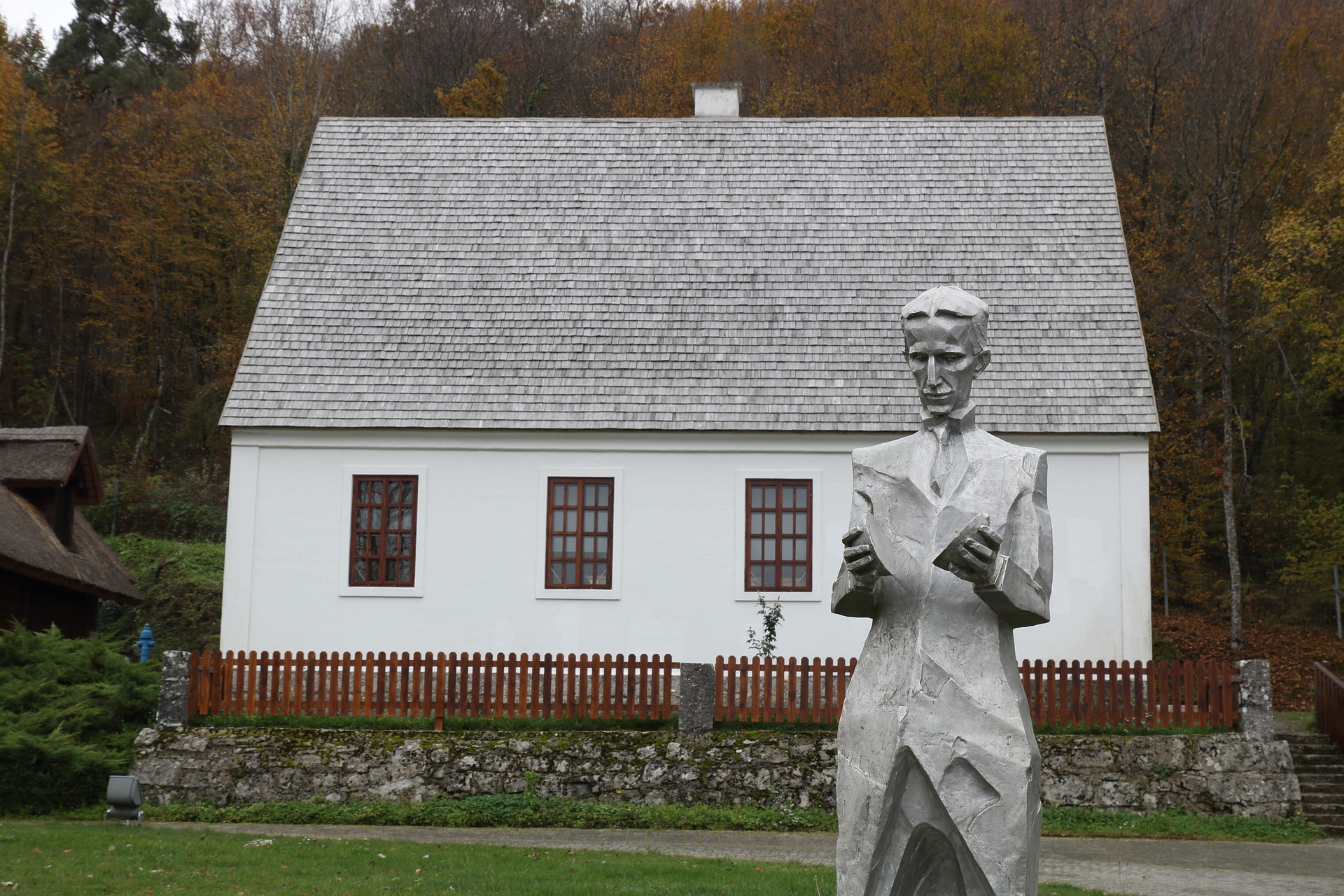
Memorial Center "Nikola Tesla" Smiljan - Pixcell
Plitvice Lakes
Probably the most well-renowned destination that Lika has to offer, Plitviče Lakes National Park is a 295 km2 forest reserve in the northeastern corner of the region. Known for its chain of 16 terraced lakes and waterfalls, this stop will bring out the inner naturalist in even the most well-established city dwellers. The park gained significant international attention in 2014 when a video of Croatian duo 2CELLOS went viral, garnering millions of views on YouTube. Even without the splendour of chordophone melodies, the natural beauty of the lakes speaks for itself, with over a million people visiting the park every year. If you want to avoid crowds, visit outside of the July-August rush. If you find yourself there during in high season, arrive early. The park opens at 7 am, and tour busses generally show up at 9 am. Most importantly, don’t make this the only stop on the Likan leg of your journey. For travellers looking to get off the beaten path, spending some time in at least one of the other options on this list will provide a more authentic and well-rounded experience.
The Croatian Littoral
If you thought Croatian maritime beauty was restricted to Dalmatia and Istria, think again. The equally magnificent Croatian Littoral lies just over the mountain from Lika’s vast woodlands. Travellers who crave the sea but shy away from crowded beaches will find Eden along this exquisite, rugged stretch of coastline. Mainly comprising the areas between Rijeka and Dalmatia, the Littoral hosts several charming seaside towns and villages with mild Mediterranean ambiance, a contrast to the more continental interior. My grandfather would recount tales of the difference in climate between his village and the coastal towns he would visit during his youth. “In my village, cold winters, but over the mountain, hot and… palm trees!” He would exclaim, testifying to the incredible variety his homeland provides.
You, too, can share in witnessing this marvel of geography. Quick day trips to the Littoral are a summer must for anyone staying in Lika. Journey to Zavratnica Bay, where you will find crystal blue waters between the steep cliffs that compose this tranquil inlet. A sunken German WWII ship can also be found here for those just as excited about diving into history as they do the ocean.
The town of Senj may also be of interest to anyone keen to embrace European history while staying dry. Stopover at Nehaj Fortress to marvel at the majesty of the stone walls that have defended the settlement as far back as 1558.
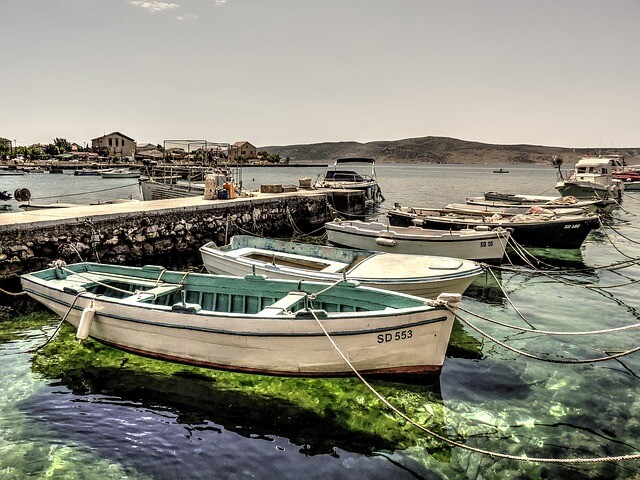
Boats in the Senj harbor - Pixabay
Gospić
The administrative center of Lika, located at the heart of the region, Gospić is an attractive destination for anyone trying to escape big crowds. Despite its modest size, the town is full of the same Southeastern European charm that invites tourists to neighbouring constituencies each year. Existing at the crossroads of empires, Gospić was initially built between two Ottoman forts, later experiencing rule under various other regimes, leaving a unique mark on the town. The proximal location of Gospic to many of Lika’s best tourist attractions makes it an ideal base from which to explore the surrounding area.
For more, check out our lifestyle section.
Croatian Foreign Trade of Goods With Russia and Ukraine
24th March 2022 – An overview of the Croatian foreign trade of goods with Russia and Ukraine in relation to the Russian invasion of Ukraine and the imposed economic sanctions on Russia.
It has been exactly one month since Russia has invaded Ukraine. Nobody knows how much more the war is going to last and we can only hope it will end soon. This is certainly one of the biggest humanitarian crises the European continent has seen in a long time. The West reacted rather promptly to the Russian invasion by imposing severe economic sanctions on the Russian Federation in an effort to persuade Russian leadership to stop the war.
Since the invasion has started, the European Union has adopted four packages of economic sanctions. Even though these sanctions still do not include all parts of the Russian economy, consumers and corporations are often choosing not to do business with Russia and Russian companies on their own initiative. I will provide an overview of the Croatian foreign trade of goods with Russia and Ukraine which will give us a better approximation of the Croatian position in these extreme circumstances.
EXPORTS
In 2021 Croatia exported 204 million Euros of goods to Russia which represents 1.1% of the total Croatian export of goods. In the last few years, Croatian export of goods to Russia has been on the rise, but they are still 28% lower than the level in 2013. In the same period, the relative share of exports to Russia has fallen from 2.9% to 1.1%.
On the other hand, Croatia has exported 58 million Euros worth of goods to Ukraine in 2021 which represents 0.3% of the total Croatian export of goods. In the observed period exports to Ukraine have been rising in absolute terms by 157% beating the total exports growth of 99%. In relative terms exports to Ukraine were fluctuating between 0.1% and 0.4%.
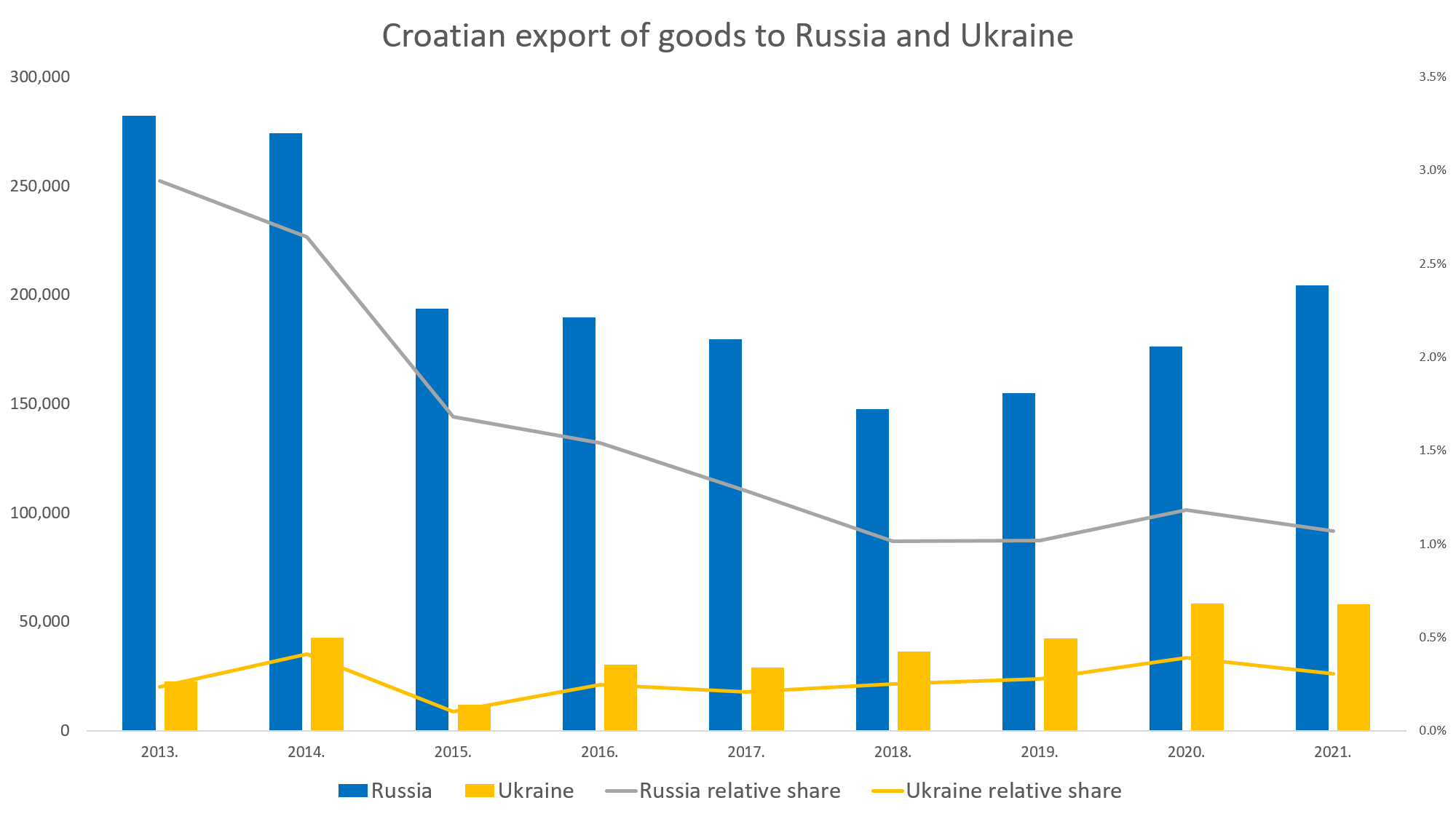
When comparing exports to Russia and Ukraine to other markets we can see that their relative importance in terms of total Croatian exports is very small. The biggest Croatian trade partner is the European Union with 69.2% of exports, followed by CEFTA countries and other countries in America with 16.3% and 3.6% respectively. What is more Russian market does not come even close to the top ten exporting countries and is far behind the Croatian traditional trade partners such as Slovenia with 13%, Italy 12%, Germany 12%, and Hungary and Bosnia and Herzegovina both with 9%.
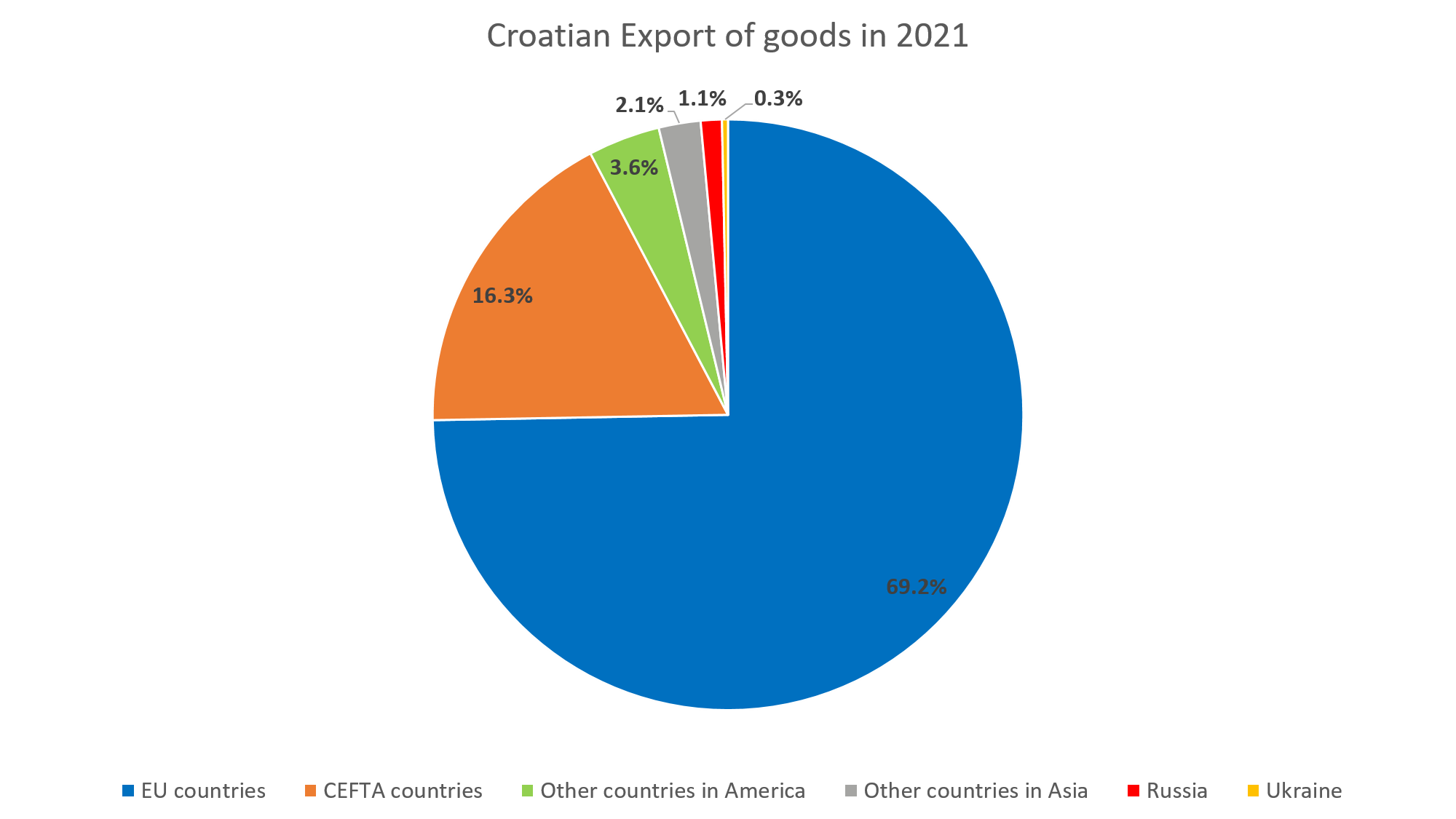
In order to dig deeper into the structure of the Croatian exports of goods to Russia and Ukraine, I have used the official Combined Nomenclature (CN) from the European Union. The breakdown of the exports by the CN is provided by the DZS and the provided data is from 2020. In the case of both Russia and Ukraine, we can see that pharmaceutical products hold the largest share of exports with 39% and 32,2% respectively. The combined export of pharmaceutical products to Russia and Ukraine account for 8.62% of total Croatian export of the same category of products. Additionally, categories (85) and (12) can be found in both Russian and Ukrainian top 5 export categories and they make up 0.64% and 17.32% of the Croatian exports in those categories, respectively.
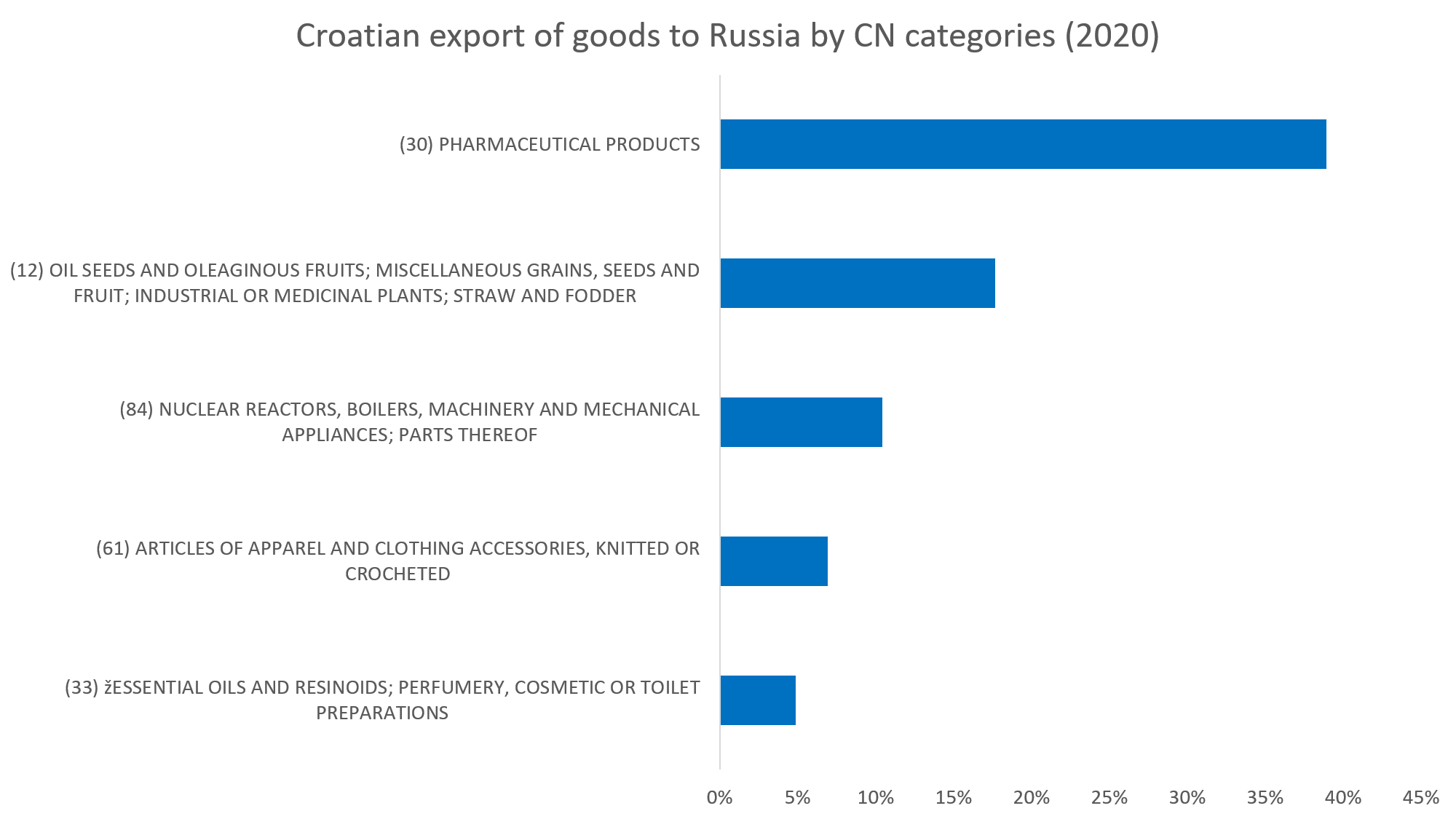
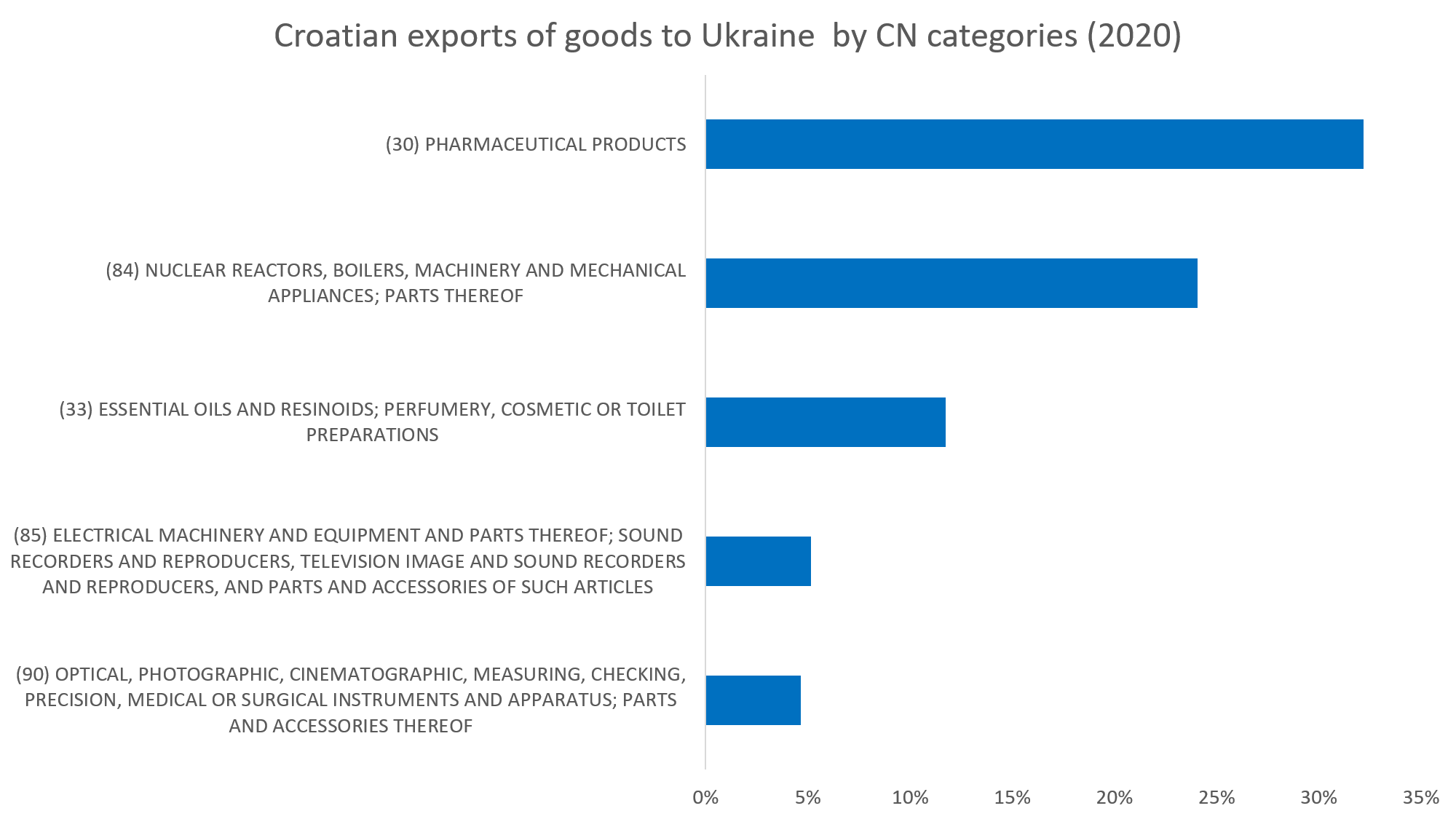
IMPORTS
Croatian imports from Russia have amounted to 463 million Euros worth of goods in 2021, which was a rise of almost 100% compared to 2020. Despite the steep rise imports from Russia are still lower by 38% compared to 2013. The relative share of Russian imports in the total Croatian imports has fallen from 4,5% in 2013 to 1,6% in 2021.
In 2021 Croatia has imported 44 million Euros worth of goods from Ukraine which is a drop of 67% from the peak in 2013. The relative share of Ukrainian imports also fell in 2014 and is around 0.2% since then.
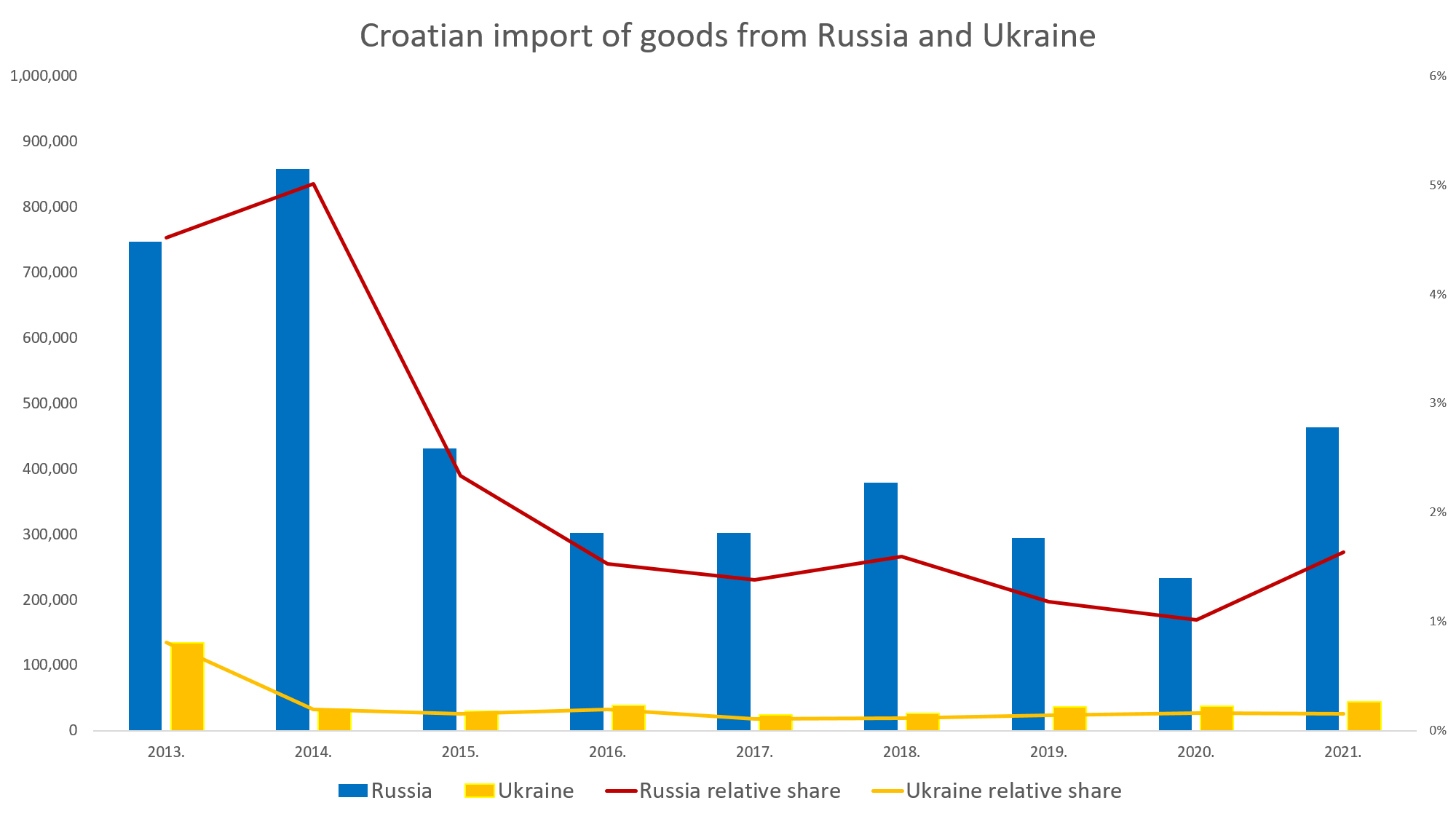
Again, as with the exports, to put it into perspective we can observe the relative share of the Russian and Ukrainian imports compared to other markets. Not surprisingly, EU markets make up the largest share of Croatian imports with 76.5%, followed by CEFTA countries and other countries in Asia with 6.8% and 7.7% respectively. Here we see the same pattern as we did with exports, the Croatian economy is not very reliant on neither Russian nor Ukrainian imports. Moreover, Russia is not even close to Croatia’s biggest importers such as Germany 15%, Italy 13%, Slovenia 11%, Hungary 7%, and Austria 6%.

When observing the CN categories, we can see that imports from Russia are dominated by mineral fuels and oils which make up 55.8% of total imports from Russia. However, the relative share of mineral fuels and oils from Russia makes up just 6.6% of total Croatian imports of the same category. Not surprisingly other important categories are metals such as aluminum and copper as well as fertilizers.
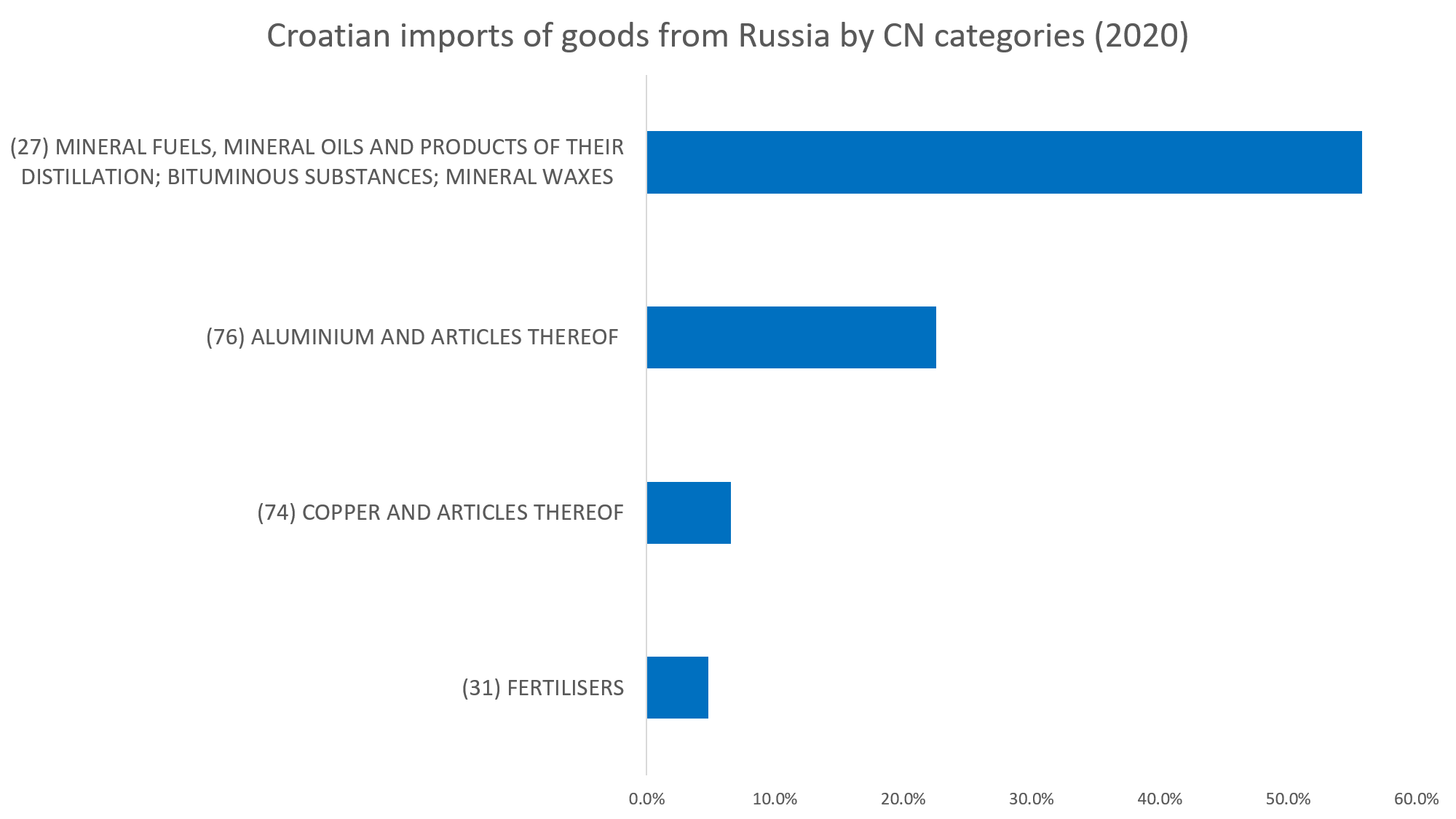
Croatian imports from Ukraine are more evenly distributed and two main categories are (84) and (85) which together account for 1/3 of imports and these are both important export categories to Ukraine as well.
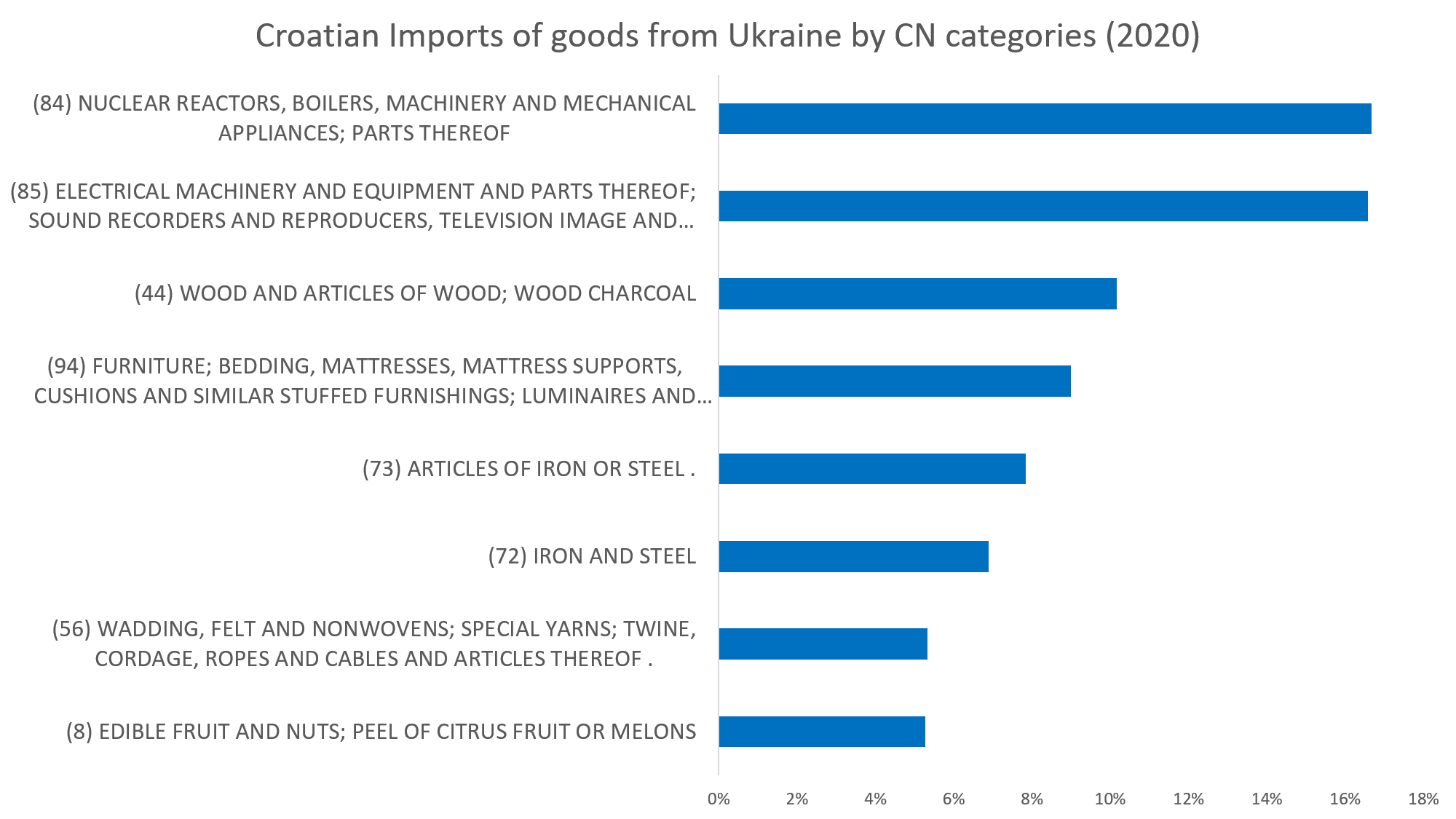
BALANCE OF TRADE
As seen on the graph below, Croatia ended 2021 with a positive trade balance with Ukraine in the amount of 14 million Euros. Since 2017 Croatia has maintained a trade surplus with Ukraine. On the other side, the Croatian trade balance with Russia was negative throughout the whole observed period. In 2021 Croatia had a trade deficit in the amount of 259 million Euros.
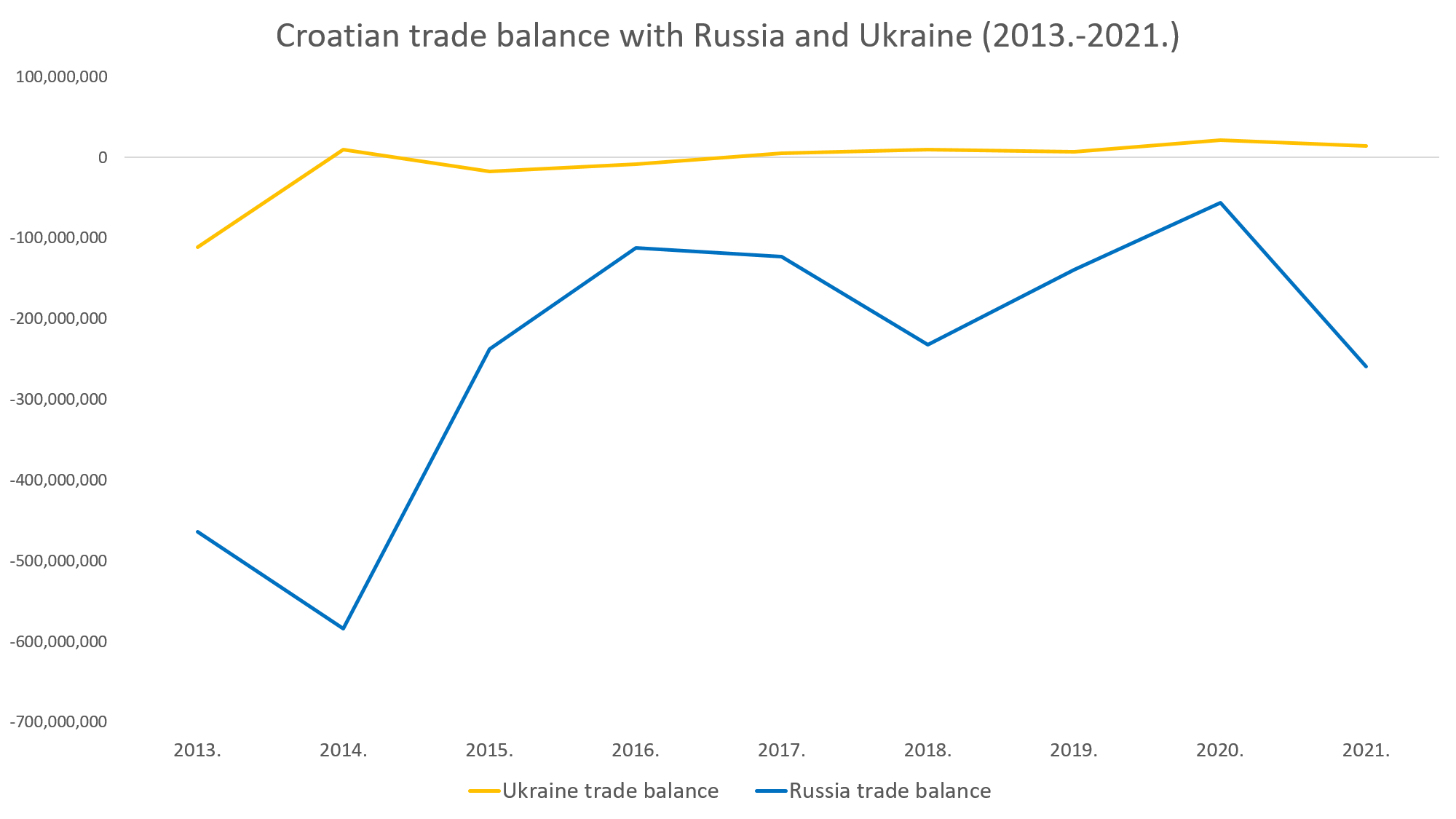
To conclude Croatian foreign trade of goods is not very reliant on the Russian and Ukrainian markets, but the Croatian economy will still suffer the consequences of the imposed sanctions on Russia and from the resulting crisis. Some industries and even more companies are more exposed to these markets and they will hopefully manage this crisis in the best way they can. On the contrary, even though the trade relation with Russia and Ukraine is relatively insignificant, Croatia’s biggest trade partners are mostly European countries which are all impacted to a large extent and the spill-over effect is unfortunately unavoidable.
If you want to find out how the Russian Invasion of Ukraine has impacted the Croatian equity market click here.
All the information provided in this article is taken from the Croatian Bureau of Statistics.
For more, check out our business section.
Croatian Conversation: 5 Years Ago There Were Almost no Women, Today it’s 50/50
23 March 2022 - Although progress has been made over the past 10 years on gender equality within Croatia and the EU, admittedly the road ahead is still a long one. In this episode of Croatian Conversation, I chat with two women in the Croatian STEM industry to get a grounded perspective on some of these issues, and improvements made over the years.
I’d like Total Croatia News readers to warmly welcome two highly accomplished women, Ivona and Nikolina, in this new episode of Croatian Conversation. Ivona is a final year computer science student at the University of Split, while Nikolina is a full-stack developer working for an international telecommunications software firm.
We’ll be hearing their perspectives on working in the STEM industry, the changing attitudes towards women in STEM, and of leaving Croatia to seek greener pastures.
Read on as we chat about positive change, career options in Dalmatia, cheap cafeteria lunches, family influences, and more.

Gender equality in STEM industries is improving. (Image: Pexels)
Thank you both for doing this! How did you come to learn about software engineering and why choose a career, or study in this field?
N: Basically, from primary school, I was good at math and physics, and it was like “Okay. I don't want to be a teacher”, and I always had problems with Croatian and with English, so I started looking more at this (technology) industry.
Also, I was deciding between medicine and engineering. When I was little, I said that I will be a kinesiologist, with diet, nutrition, and working out, but unfortunately, I didn’t have the marks (grades) for medicine.
And what about you Ivona, kind of the same outlook?
I: Actually, I was quite the opposite. I was more about languages. Yeah, but there was also a kind of, well, let’s call it a problem. I was raised in a family where everyone went to school related to some kind of IT (information technology).
My father always said that my mother is the reason why I didn't do the same and did languages instead. She said going to high school for computer science or electronics, there were a lot of men, and she didn't allow that. She told me that I would be the only girl in that school, and that might be a problem.
So, I didn't know what the next step would be for me. Even in primary school, between languages and math, I was actually good at both so, I decided to go to gymnasium for French and English.
N: I learned Italian but forgot everything. Maybe now I can still understand something. But yeah, it was bad.
Right, so you (N) liked math and physics? Yeah. And you (I) were more into languages?
I: Yeah. I wasn't sure what I wanted to do with my life (career wise). So, I just decided, “Oh, I’m good at languages”. I even studied Italian; it was cool, but when I went to gymnasium (high school), I figured out that it (languages) was not for me.
Why do you say that?
I: I don't know, I figured out that I didn’t want to teach because I’m not someone who can work with a lot of kids. And I had some problems with English during gymnasium because my teacher was quite strict. Then I thought that's (languages) definitely not for me, and the next question was, what's next? So, I decided to try this (computer science).
It's interesting that both of you say that you didn't want to be teachers. Was that a traditional career path to follow?
N: Yes, sort of, but now I sometimes I think I could (be a teacher)? But then, it was a little bit worrying when you teach the same thing every year. I think you should always get some different tasks, always create something new. In teaching, I think that is difficult.
So, you like new challenges and not doing the same repetitive tasks all the time?
N: Yeah, definitely.

Teaching is considered a traditional career path for women in STEM. (Photo: Matija Habljak/PIXSELL)
Okay. And for you (I)?
I: From my side, it’s really hard to teach kids. It's a huge responsibility and I kind of know that in Split, it's really hard to get a job (teaching). So, that was also one big part in deciding why I have to go to college for five years (in IT), to find a job (in Split).
Right. And what about you N? Were you more certain that you would get a job within the engineering and tech industry?
N: Yeah, I think you have more options than a teacher.
Okay. And was your family supportive?
N: Yeah, they were super supportive because they did not go to college, just high school, and they pushed me to learn, to have a better life.
I: But it's very interesting that now, my mother is now the biggest motivator. She always says “you can do it now that it's different”.
That’s great!
I: Because she figured out that it’s not only a job for a man, so now she's supportive. Before, I was also thinking of whether this (industry) was for me? I don't know why I thought this way, maybe it's old school? But I think (the attitude) is changing.
Right, different times
I: Women didn't even have the same opportunities to go to school.
The conversation is interrupted by another intern from the marketing department, as we take a detour into the lives of university students in Split.
I: Would you like something from college? We have meals but only for students, there’s like a card and at the restaurant (University cafeteria), it's 50% cheaper.
Interesting, what’s this about, like how much do you pay for lunch?
I: Something like 8 kunas? (Approximately €1.06)
What do you get for 8 kunas?
N: Sometimes bad stuff.
I: Meat, salad, but it's like a meal. That means so you can choose every day you have, maybe five different dishes. And then students who live in another city or have more money. I'm from Kaštela, and I think I get around 160 kunas every month. I think this (initiative) is for all students in Croatia.
Oh cool, but let’s get back on track. So (N) you were saying you are actually an electrical engineering graduate, why did you go into programming?
N: From electrical engineering, I went to telecommunications and informatics (2-year master’s program) and applied for this job to learn more about programming because I liked the logic (behind programming) better.
I: Yeah, I also started electrical (engineering) for two years but didn’t feel like I’d learned anything. Now (with programming) I feel like I’m learning how to do something.
What about for you (I), why did you change industries?
I: Well actually, it’s not only about the job, I think to be hired, it’s also based on your projects or skills. Through studying computer science, I realized I could do something practical so that’s why I’m here (as an intern), because you can learn so much (from the internship).
I see, so computer science is more logical and hands-on.
I: The first and second year of programming was so hard for me. But basic software engineering was easier than pure theory, you get to do something. They give you the opportunity to learn and you also have a chance to ask, if you're just waiting for someone to notice you *shakes head* you can’t.
N: Yeah, you do ask a lot (of questions)
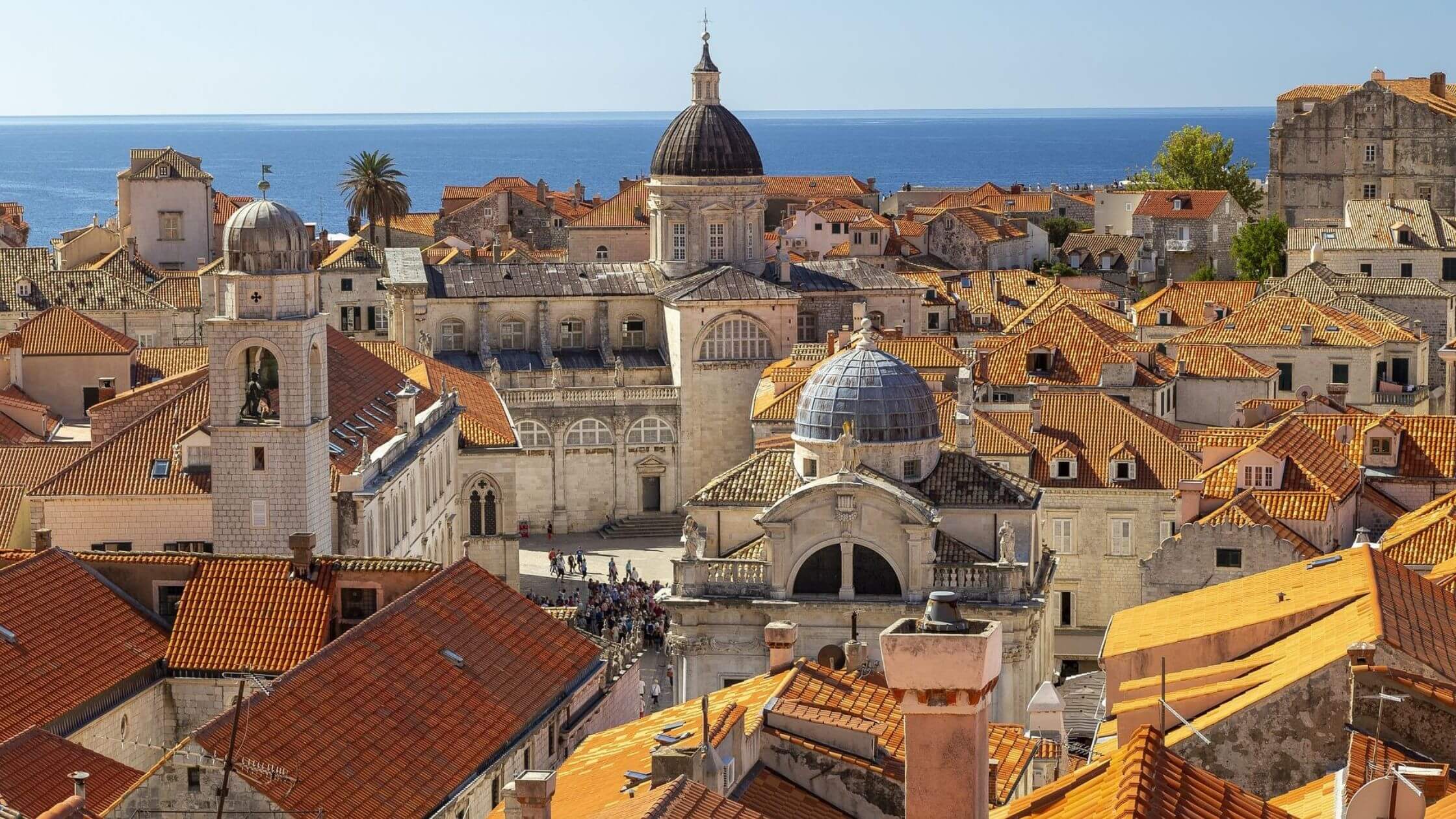
Both talk about how they enjoy the logic and rationale behind coding and programming. (Image: Pexels)
There are also a lot of people who have an engineering degree, but then they end up working outside the industry, why do you think that's the case?
I: Well, to be honest, some people just want a degree. It's not important for them what the degree is, they just want it for now and maybe one day in the future decide if they will work in the field. A lot of my friends (who graduated) were asking if this was the right decision. But their problem is they don't want to try (to get a job in the industry).
And if you try for one year or two years, however long, you have time to figure out if this is for you or not. I think that there are a lot of companies that are giving students these opportunities, but (students) are not taking them. I don’t know why.
Right. And what about you N, when you graduated? Do you find all your friends working in the field?
N: I think some are in teaching and some are still without jobs because they don't have the right skills. So, I think they are trying to create some projects to put on their CV. Basically before (this job), I applied to different companies and I was worried about my 5 years spent (in college) and if I even knew anything, so this was what scared me (regarding jobs and the industry).
I see, also do you see yourself staying in this field?
N: Sometimes I feel that this is for me, sometimes I feel it isn't. But more so I see myself staying. I think it will get better with more interesting work, but I feel I'm better here (in the software industry) generally.

Nikolina standing outside the faculty building after successfully defending her Master's thesis. (Image: Nikolina Zelic/Personal album)
Yeah. And for you (I), do you feel as a woman in engineering any different?
I: No, I think everything is the same.
Great, so you see yourself exploring this more?
I: Yes, for now. I am really happy here. I don't know, maybe I’m different. Because at first it was difficult but my colleague, he also helps a lot. A lot! When I have some problem with anything, I can ask him.
He also really encouraged me to try after doing the hackathon here (in December 2021). If I didn't hear from someone who is working in this field for a few years, I don't know, would probably say, I'm not sure (about staying in the field). But he really encouraged me to try and said that I will learn something.
Right, that’s really cool that you have supportive colleagues. I have another question about school, did you have a lot of female engineers in your courses?
I: Yeah, but when I was in the first year, they told us that five years ago, there were almost no women in the faculty.
What do you think is the split now?
Both: 50-50? Yeah, 50-50.
Wow, ok.
I: Well, I think it's more women than men, actually. Now at least, but we can say 50-50.
N: Yeah. Maybe for telecommunications, I think there are more women.
Great, before we close, I have a final question, with the latest census results, have either of you thought of leaving Croatia? For better jobs or salaries?
N: Well, I love Canada so much.

Croatia has seen a population decline of almost 10% over the last decade, with the younger generation leaving to seek better opportunities overseas. (Image: DZS/Facebook screenshot)
Have you been before?
N: No, no, no. But I just love that country. I don't know why.
Okay. Maybe something you in the media.
N: Yes, it seems much better and nicer, but it depends on the province? I just want to try, to see how it's like working in another country, in any country. It can be in Germany, if not somewhere.
For you, Ivana, you seemed more hesitant to the idea?
I: Yeah, working and living here. Definitely, I can say I would like to (continue). My friends and family are here and when I step out of the house, there’s the sea right at my door. Well, I live in Kaštela, it’s a little bit different than Split right, it's more casual but yeah, I really like it.
Cool, well thank you ladies for this chat, I feel I know more about the STEM industry and the Croatian education system in general!
For more, check our lifestyle section.


